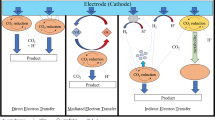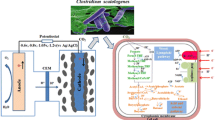Abstract
Microbial electrosynthesis (MES) is an innovative technology, which can yield valuable organic chemicals with concomitant CO2 sequestration by employing microbes as biocatalysts. The mode of operation has an imperative role in the performance of MES, thus, affecting the yield of synthesized organic chemicals from the MES. However, to the best of our knowledge, the optimal mode of operation for MES has not been determined till date. Hence, in the present investigation, two MES were operated: one in batch mode (MES-B) and another in continuous mode (MES-C), and their performance was monitored. The MES-B exhibited 31%, 33.5% and 44% higher production rate of acetate, propionate and butyrate, respectively, in comparison to MES-C. Moreover, the performance of MES-B also stabilized faster, and microbiome in the cathodic chamber of MES-B was able to accept 26% more electrons supplied to it externally, which were employed as reducing equivalents to reduce CO2. The enactment of MES-B was superior to that of MES-C due to the higher retention of CO2 and hydrogen in cathodic chamber of MES-B. Therefore, operating MES in batch mode would aid in yielding more organic chemicals through CO2 sequestration.
Graphic abstract




Similar content being viewed by others
References
Nevin KP, Woodard TL, Franks AE, Summers ZM, Lovley DR (2010) Microbial electrosynthesis: feeding microbes electricity to convert carbon dioxide and water to multicarbon extracellular organic compounds. mBio 1 (2):e00103-00110-e00103-00110. https://doi.org/https://doi.org/10.1128/mBio.00103-10
Das S, Das I, Ghangrekar M (2020) Role of applied potential on microbial electrosynthesis of organic compounds through carbon dioxide sequestration. J Environ Chem Eng 8(4):104028. https://doi.org/10.1016/j.jece.2020.104028
Fukushima T, Yamauchi M (2020) Electrosynthesis of glycine from bio-derivable oxalic acid. J Appl Electrochem. https://doi.org/10.1007/s10800-020-01428-x
Raychaudhuri A, Behera M (2020) Comparative evaluation of methanogenesis suppression methods in microbial fuel cell during rice mill wastewater treatment. Environ Technol Innov 17:100509. https://doi.org/10.1016/j.eti.2019.100509
Das S, Mishra A, Ghangrekar M (2020) Production of hydrogen peroxide using various metal-based catalysts in electrochemical and bioelectrochemical systems: mini review. J Hazard Toxic Radioact Waste 24(3):06020001. https://doi.org/10.1061/(ASCE)HZ.2153-5515.0000498
Türk K, Kruusenberg I, Kibena-Põldsepp E, Bhowmick G, Kook M, Tammeveski K, Matisen L, Merisalu M, Sammelselg V, Ghangrekar M (2018) Novel multi walled carbon nanotube based nitrogen impregnated Co and Fe cathode catalysts for improved microbial fuel cell performance. Int J Hydrogen Energy 43(51):23027–23035. https://doi.org/10.1016/j.ijhydene.2018.10.143
Sharma V, Kundu P (2010) Biocatalysts in microbial fuel cells. Enzyme Microb Technol 47(5):179–188. https://doi.org/10.1016/j.enzmictec.2010.07.001
Feng Q, Song Y-C (2016) Decoration of graphite fiber fabric cathode with electron transfer assisting material for enhanced bioelectrochemical methane production. J Appl Electrochem 46(12):1211–1219. https://doi.org/10.1007/s10800-016-1003-8
Cercado B, Cházaro-Ruiz LF, Trejo-Córdova G, Buitrón G, Razo-Flores E (2016) Characterization of oxidized carbon foil as a low-cost alternative to carbon felt-based electrodes in bioelectrochemical systems. J Appl Electrochem 46(2):217–227. https://doi.org/10.1007/s10800-015-0906-0
Das S, Das S, Das I, Ghangrekar M (2019) Application of bioelectrochemical systems for carbon dioxide sequestration and concomitant valuable recovery: a review. Mater Sci Energy Technol 2(3):687–696. https://doi.org/10.1016/j.mset.2019.08.003
Das S, Diels L, Pant D, Patil AS, Ghangrekar M (2020) Microbial electrosynthesis: A way towards the production of electro-commodities through carbon sequestration with microbes as biocatalysts. J Electrochem Soc. https://doi.org/10.1149/1945-7111/abb836
Srikanth S, Maesen M, Dominguez-Benetton X, Vanbroekhoven K, Pant D (2014) Enzymatic electrosynthesis of formate through CO2 sequestration/reduction in a bioelectrochemical system (BES). Bioresour Technol 165:350–354. https://doi.org/10.1016/j.biortech.2014.01.129
Roy S, Schievano A, Pant D (2016) Electro-stimulated microbial factory for value added product synthesis. Bioresour Technol 213:129–139. https://doi.org/10.1016/j.biortech.2016.03.052
Das I, Das S, Ghangrekar M (2020) Application of bimetallic low-cost CuZn as oxygen reduction cathode catalyst in lab-scale and field-scale microbial fuel cell. Chem Phys Lett 751:137536. https://doi.org/10.1016/j.cplett.2020.137536
Jourdin L, Freguia S, Flexer V, Keller J (2016) Bringing high-rate, CO2-based microbial electrosynthesis closer to practical implementation through improved electrode design and operating conditions. Environ Sci Technol 50(4):1982–1989. https://doi.org/10.1021/acs.est.5b04431
Das S, Chakraborty I, Das S, Ghangrekar M (2020) Application of novel modular reactor for microbial electrosynthesis employing imposed potential with concomitant separation of acetic acid. Sustain Energy Technol Assess 43:100902. https://doi.org/10.1016/j.seta.2020.100902
Cheng S, Xing D, Call DF, Logan BE (2009) Direct biological conversion of electrical current into methane by electromethanogenesis. Environ Sci Technol 43(10):3953–3958. https://doi.org/10.1021/es803531g
Aryal N, Halder A, Tremblay P-L, Chi Q, Zhang T (2016) Enhanced microbial electrosynthesis with three-dimensional graphene functionalized cathodes fabricated via solvothermal synthesis. Electrochim Acta 217:117–122. https://doi.org/10.1016/j.electacta.2016.09.063
Das S, Das S, Ghangrekar M (2020) Application of TiO2 and Rh as cathode catalyst to boost the microbial electrosynthesis of organic compounds through CO2 sequestration. Process Biochem 101:237–246. https://doi.org/10.1016/j.procbio.2020.11.017
Aryal N, Ammam F, Patil SA, Pant D (2017) An overview of cathode materials for microbial electrosynthesis of chemicals from carbon dioxide. Green Chem 19(24):5748–5760. https://doi.org/10.1039/C7GC01801K
Gildemyn S, Verbeeck K, Jansen R, Rabaey K (2017) The type of ion selective membrane determines stability and production levels of microbial electrosynthesis. Bioresour Technol 224:358–364. https://doi.org/10.1016/j.biortech.2016.11.088
Bian B, Alqahtani MF, Katuri KP, Liu D, Bajracharya S, Lai Z, Rabaey K, Saikaly PE (2018) Porous nickel hollow fiber cathodes coated with CNTs for efficient microbial electrosynthesis of acetate from CO2 using Sporomusa ovata. J Mater Chem A 6(35):17201–17211. https://doi.org/10.1039/C8TA05322G
Modestra JA, Mohan SV (2017) Microbial electrosynthesis of carboxylic acids through CO2 reduction with selectively enriched biocatalyst: microbial dynamics. J CO Util 20:190–199. https://doi.org/10.1016/j.jcou.2017.05.011
Bajracharya S, Vanbroekhoven K, Buisman C, Strik D, Deepak P (2017) Bioelectrochemical conversion of CO2 to chemicals: CO2 as next generation feedstock for the electricity-driven bioproduction in batch and continuous mode. Faraday Discuss 202:433–449
Bajracharya S, Yuliasni R, Vanbroekhoven K, Buisman CJ, Strik DP, Pant D (2017) Long-term operation of microbial electrosynthesis cell reducing CO2 to multi-carbon chemicals with a mixed culture avoiding methanogenesis. Bioelectrochemistry 113:26–34. https://doi.org/10.1016/j.bioelechem.2016.09.001
Das S, Ghangrekar M (2019) Tungsten oxide as electrocatalyst for improved power generation and wastewater treatment in microbial fuel cell. Environ Technol. https://doi.org/10.1080/09593330.2019.1575477
Groher A, Weuster-Botz D (2016) General medium for the autotrophic cultivation of acetogens. Bioprocess Biosyst Eng 39(10):1645–1650. https://doi.org/10.1007/s00449-016-1634-5
Das S, Chatterjee P, Ghangrekar M (2018) Increasing methane content in biogas and simultaneous value added product recovery using microbial electrosynthesis. Water Sci Technol 77(5):1293–1302. https://doi.org/10.2166/wst.2018.002
Das I, Das S, Dixit R, Ghangrekar M (2020) Goethite supplemented natural clay ceramic as an alternative proton exchange membrane and its application in microbial fuel cell. Ionics. https://doi.org/10.1007/s11581-020-03472-1
Das S, Ghangrekar M (2018) Value added product recovery and carbon dioxide sequestration from biogas using microbial electrosynthesis. Indian J Exp Biol 56:470–478
Bajracharya S, ter Heijne A, Dominguez Benetton X, Vanbroekhoven K, Buisman CJ, Strik DP, Pant D (2015) Carbon dioxide reduction by mixed and pure cultures in microbial electrosynthesis using an assembly of graphite felt and stainless steel as a cathode. Bioresour Technol 195:14–24. https://doi.org/10.1016/j.biortech.2015.05.081
Blanchet E, Duquenne F, Rafrafi Y, Etcheverry L, Erable B, Bergel A (2015) Importance of the hydrogen route in up-scaling electrosynthesis for microbial CO2 reduction. Energy Environ Sci 8(12):3731–3744. https://doi.org/10.1039/C5EE03088A
Jourdin L, Lu Y, Flexer V, Keller J, Freguia S (2016) Biologically induced hydrogen production drives high rate/high efficiency microbial electrosynthesis of acetate from carbon dioxide. ChemElectroChem 3(4):581–591. https://doi.org/10.1002/celc.201500530
Aryal N, Tremblay P-L, Lizak DM, Zhang T (2017) Performance of different Sporomusa species for the microbial electrosynthesis of acetate from carbon dioxide. Bioresour Technol 233:184–190. https://doi.org/10.1016/j.biortech.2017.02.128
Batlle-Vilanova P, Puig S, Gonzalez-Olmos R, Balaguer MD, Colprim J (2016) Continuous acetate production through microbial electrosynthesis from CO2 with microbial mixed culture. J Chem Technol Biotechnol 91(4):921–927. https://doi.org/10.1002/jctb.4657
Su M, Jiang Y, Li D (2013) Production of acetate from carbon dioxide in bioelectrochemical systems based on autotrophic mixed culture. J Microbiol Biotechnol 23(8):1140–1146. https://doi.org/10.4014/jmb.1304.04039
Aryal N, Halder A, Zhang M, Whelan PR, Tremblay P-L, Chi Q, Zhang T (2017) Freestanding and flexible graphene papers as bioelectrochemical cathode for selective and efficient CO2 conversion. Sci Rep 7(1):1–8. https://doi.org/10.1038/s41598-017-09841-7
Ljungdahl LG (1986) The autotrophic pathway of acetate synthesis in acetogenic bacteria. Annu Rev Microbiol 40:415–450
Christodoulou X, Velasquez-Orta SB (2016) Microbial Electrosynthesis and Anaerobic Fermentation: An Economic Evaluation for Acetic Acid Production from CO2 and CO. Environ Sci Technol 50(20):11234–11242. https://doi.org/10.1021/acs.est.6b02101
Funding
This work was financially supported by The Ministry of Human Resource Development, Government of India (SAP17_IITKGP_05).
Author information
Authors and Affiliations
Contributions
SD: conceptualization; data curation; formal analysis; investigation; methodology; software; validation; visualization; roles/writing—original draft; writing—review and editing. MMG: funding acquisition; project administration; resources; supervision; validation; writing—review and editing.
Corresponding author
Ethics declarations
Conflict of interest
The authors declare that they have no known competing financial interests or personal relationships that could have appeared to influence the work reported in this paper.
Availability of data and material
The datasets generated during and/or analysed during the current study are available from the corresponding author on reasonable request.
Additional information
Publisher's Note
Springer Nature remains neutral with regard to jurisdictional claims in published maps and institutional affiliations.
Rights and permissions
About this article
Cite this article
Das, S., Ghangrekar, M.M. Performance comparison between batch and continuous mode of operation of microbial electrosynthesis for the production of organic chemicals. J Appl Electrochem 51, 715–725 (2021). https://doi.org/10.1007/s10800-020-01524-y
Received:
Accepted:
Published:
Issue Date:
DOI: https://doi.org/10.1007/s10800-020-01524-y




